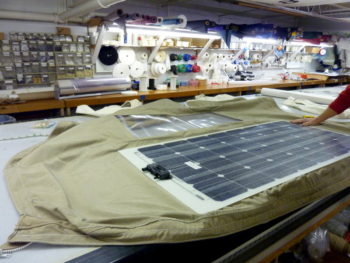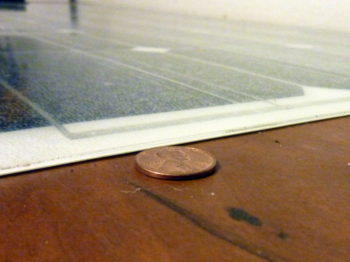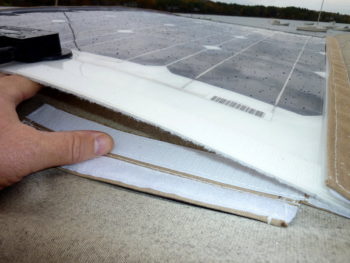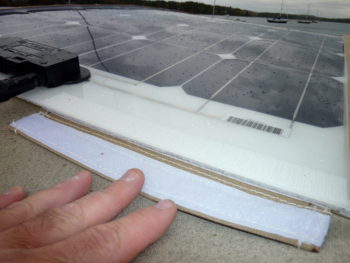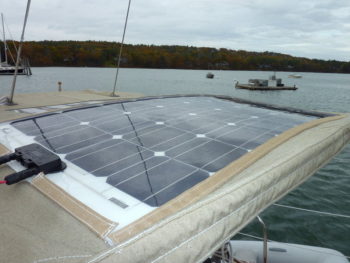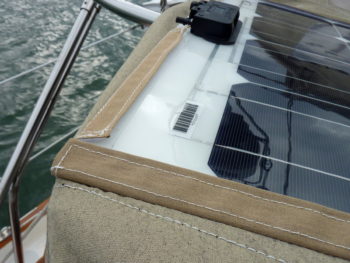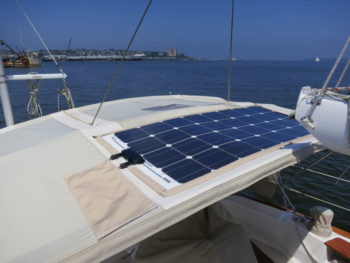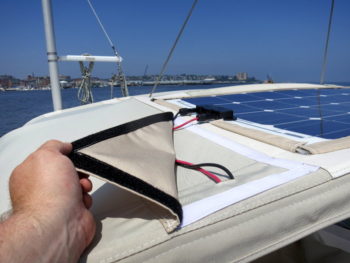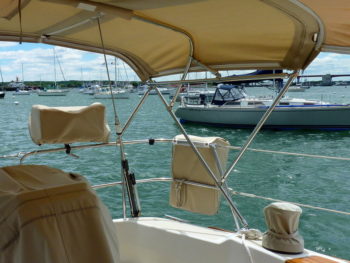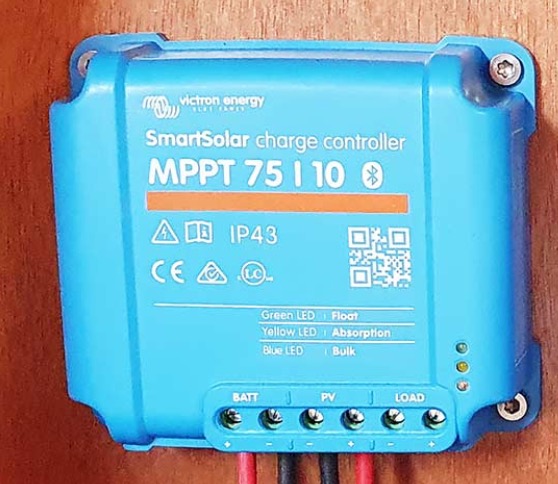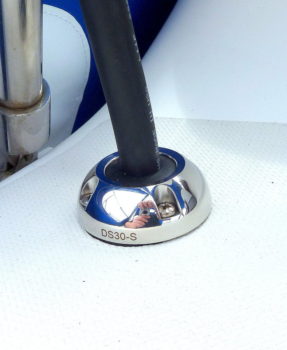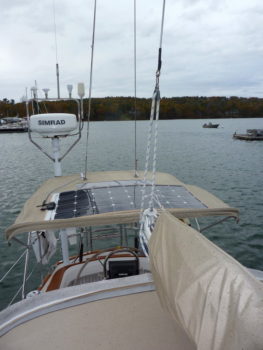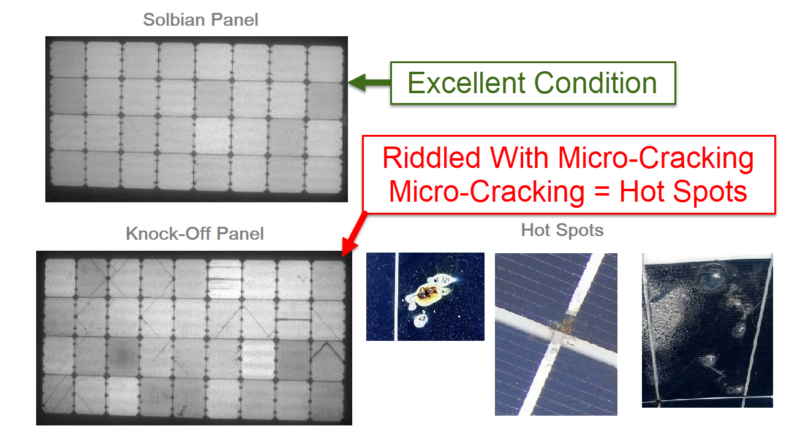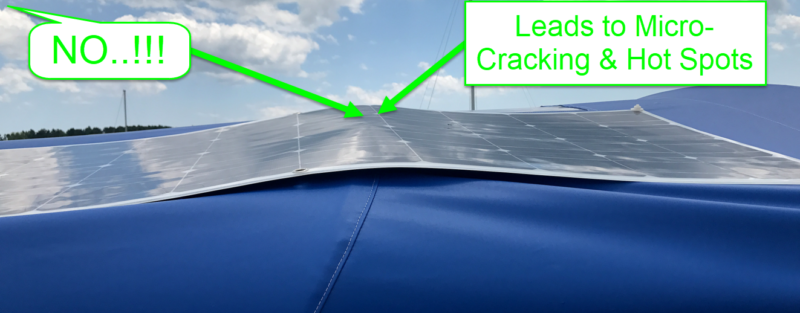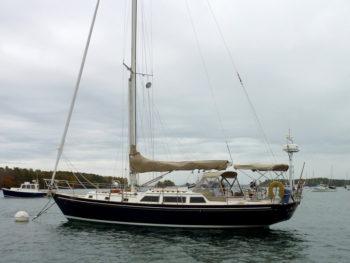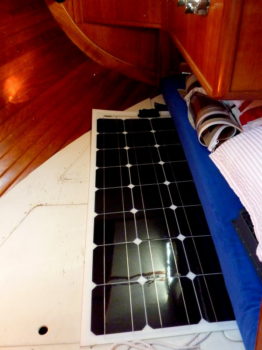Panel Layout
In this article we used a Solbian panel that is no longer in production. Solbian solar panels are a unique product that fill a great niche for the marine market. They are really the absolute top tier semi-flexible panel and the Pricing reflects that.We recommend some affordable alternatives below.
In this photo the panel is being laid out on a used bimini. Our canvas maker, Richard Hallett of Hallett Canvas & Sails, decided on Velcro for the fastening of the panel to the bimini. Because the entire panel weighs under 5 pounds, direct mounting to most soft bimini tops makes this a very neat and tidy fitment.
MHT Recommended Products (12/22)
Premium Grade Solar Panels
SunPower 100W Semi-flex Panel (Amazon Link)
SunPower 50W Semi-flex Panel (Amazon Link)
SunPower 50W Semi-flex Panel (Amazon Link)
Penny Pincher GradeSolar Panels
Top Solar 100W Solar Panel (Amazon Link)
Premium Grade MPPT Controllers
Victron Smart Solar 75V IN 10A OUT( Amazon Link)
Penny Pincher Grade MPPT
Very, Very Thin!
As can be seen these Semi-flexible panels are very thin. Unlike previous armorphous “flexible” panels the these are a monocrystalline panel. This makes them about half the size of a comparable armorphous panel and very efficient for the real estate they take up. SunPower panels use only premium graded SunPower® cells. Currently SunPower® is making the most efficient cells on the market.
The benefits of semi-flex panels can be unique and necessary for some installations. Are these panels more expensive than traditional panels?
Things to consider:
#1 The ultra light weight of these panels means they can be affixed to most any Sunbrella type bimini or dodger (consider shading on dodgers).
#2 This weight savings usually means the original bimini frame is more than strong enough for the added weight of the Semi-flex panels. The last rigid solar panel I installed, in the 125W range, weighed 28 pounds. This was just the weight of the panel alone and did not include the extra stainless tube, fittings & aluminum framing needed for attaching it to the bimini. When all was said and done this single 125W panel added well over 40 pounds to the top of the bimini. This panel weighs just under 5 pounds. This is a huge weight savings.
#3 When fitting a traditional rigid panel to a bimini, a frame needs to be custom built at the expense of the fittings, stainless tubing and the aluminum support frame for the rigid panel. This can run into the hundreds of dollars in just supplies not including custom tube bending/crowning etc. etc.
#4 When fitting a rigid panel to a bimini, the bimini often needs to be converted to a full strapless type bimini. The fittings and stainless tube for this add even more money to the up-front project costs.
Prime Example of Semi-Flex Benefit
Sorry for the grainy photo. In this photo you can see two 130W Kyocera rigid panels installed onto a custom built frame. The owner of this vessel had this fully custom frame built to fit over the existing bimini in order to support the weight of this 260W array. The cost of this installation far exceeded what the cost would have been to install two Solbian CP-125 panels. For the 10W difference the savings on this install would have been quite large even with the Solbian panels costing twice as much.
The Solbian’s can also easily be removed and stowed where the rigid panels become bulky, tedious and can damage your vessels interior..
Velcro Attachment
Richard, of Hallett Sails, decided that dual Velcro, both top and bottom, with a lapel was the best method to attach the panel to the bimini. Suffice it to say it is a very, very robust attachment.
The owner of this boat, an avid offshore voyager, has been caught in off shore storms before and wanted a solar option that allowed the easy removal of the panel. He also did not want a panel with a bulky, sharp aluminum frame to try and stow below in rough seas or for storm prep.
This Solbian CP-125 panel will easily stow below a berth cushion and not even be noticeable. He also did not want to re-invent his bimini frame which was simply not strong enough to support the weight of a rigid panel.
EDIT: 5/30/18 This panel, attached in this manner, has sailed from Maine to the Caribbean multiple times now.
Velcro Lapel
This picture shows the panels bottom Velcro and the top Velcro. The lapel is simply folded over the panel to button it up. Also take note of the slim profile of the panels junction box compared to my fingers. When stowed beneath a berth cushion you are barely able to discern a bump in the foam. This is a very nice feature for a 125W panel. There are also no sharp edges to scratch a beautifully varnished interior!!
Ready To Go
Here you can see the Velcro lapel affixed to the panel and the junction box connected to the feed wire via MC4 connectors. While I am not a big fan of “knock-off” MC4 connectors, in the marine environment, premium quality MC4’s (made by Multi-Contact) do make sense for this type of installation.
Yes, Sunbrella Does Fade
This owner was going to eventually replace the canvas but this gives an idea of just how much it can fade in 7-8 years or so. Rather than reinvent the bimini around the new panel the owner opted to just re-stitch for now and add the panel. The cost was minimal for the canvas work.
The primary role of this panel is to keep the owners Lifeline AGM batteries charged on the mooring. This boat is not sailed off a dock and is not a Marina Queen. Because this boat is rarely at a dock, getting his expensive AGM’s back to 100%, as often as possible, was the main goal here.
The owner also has a high output alternator and external regulator so the panel is only really taking his bank from 80-85% state of charge back to 100%. This was accounted for in the sizing. His bank can go from 85% SOC to 100% SOC in about 2-3 days with this panel.
Wire Lapel
Here is another boat with a similarly aged bimini. What we are looking at here is the Velcro lapel to cover the wires. If the canvas was not so faded, it would look much better.
Wire Lapel Access
This just shows the wire access under the lapel. It’s Velcro on two sides and sewn on two sides.
TIP: I find it best to trim the heavy jacket from the wire and just use the inner conductors coming up through the bimini.
Bimini & Frame Before
Not all bimini tops are created equally and there are vast differences in canvas makers and their ability to produce a quality product. Sadly this bimini was a prime example of a canvas maker who should consider serving Slurpy’s at a 7 Eleven instead of making canvas. The owner of this boat was not quite ready to invest in a new bimini & frame so the existing frame was modified to tighten & stiffen it enough to accept the Solbian panel.
What was wrong with this bimini & frame?
- Elcheapo support straps that stretch when wet and cause tripping hazards the rest of the time.
- Bimini over 10′ wide using thin wall 1″ tubing. Should have been heavy wall 1.25″..
- No support struts to prevent yawing side to side. Under sail this bimini was moving almost 6″ side to side at the top curve of the bimini tube.
- The middle bar did nothing but pull the canvas down in the middle thus creating a great spot for a puddle to drip on the owners head.
- Cheap thread was used and the bimini needed a full re-stitching in less than 4 years.
- The bias of the fabric was not considered and one panel had the bias going entirely the wrong direction.
- The fit of the fabric to the crown and curve of the bimini frame was absolutely horrible.
In short a third grader with a Playschool sewing machine could have likely done better work…. Please do not choose your canvas maker based on price, choose them based on ability. Canvas work is an art form…
Bimini & Frame After
The raw reality is that no matter how much frame work you do you’re not going to turn a child’s preschool drawing into the Mona Lisa…. What I had to do to this frame was run angled supports to the stern pushpit in order to help minimize the side to side sway/yawing. This was still a 1″ OD X 10′ plus wide bimini using cheap, thin walled tube. The cross braces helped immensely but a proper frame, in thick walled 1.25″ tube, was really in order. Who ever paid for this canvas originally, got royally screwed.
I next installed a strut between the aft frame and the fore frame to better tension the fabric. Because the fabric never fit right to begin with it still was not a perfect fit. I was able to get it tight enough for the Solbian panel but it still looked pretty ill fitting. These tweaks bought the owner some time until a qualified canvas maker could build him a new bimini. The aft eye-end jaw is adjustable and Gemini stand offs were used for the fore to aft strut.
Once the fore and aft frames were tensioned, the third (middle) frame was still pulling the mid point of the fabric into a puddle forming dip. I used a third short bracing strut to force the third frame into doing its job. Again, because the fabric never fit right to begin with, and this bimini was horribly made, I did the best I could with what I had to work with.
Most bimini’s will require some additional support when you add another 5-10 pounds on-top of them. By going to rigid supports, as opposed to stretchy nylon Mickey-Mouse straps, you lose the forward tripping hazard and you can properly tension the fabric. Once tensioned the fabric should not stretch any further, unless of course the bias is incorrectly laid out.
Consider working directly with a qualified canvas maker when designing your bimini to accept a semi-flexible panel. The bimini should fit drum tight and be well braced both fore and aft and side to side.
Coupled With a Victron 75/10 Smart Solar MPPT Controller
Today we typically install: Victron SmartSolar MPPT Controllers (LINK). These controllers are fast, very, very competitively priced, 100% programmable and come in two varieties BlueSolar (no built in bluetooth) and SmartSolar (Built in Bluetooth). We highly recommend only purchasing the SmartSolar models.
For a charge controller on this install (before Victron Controller even launched) I coupled the Solbian CP-125 with the simple but very effective Genasun GV-10 MPPT controller. The Genasun controllers are great little controllers, and extremely fast tracking, if the factory preset voltage profiles work for your bank. If the Gensun voltages don’t match your battery, buy a Victron!
On boats, where movement and shading will be an issue, you want a fast tracking MPPT controller in order to maximize your PV output. Sadly the speed an MPPT tracks at, is far too often left out of the conversation. While land based MPPT controllers can get away with slower tracking on a boat we can’t. Almost all the cheap Chinese MPPT’s track at snail speeds compared to the brands listed below. Today, in this price range of controller,we are installing the small Victron controllers because they’re programmable right out of the box and with no custom programming up-charge to do so..
Regardless of what you choose for an MPPT controller always choose a fast-tracking MPPT controller. Brands utilizing fast tracking algorithms:
- Morningstar
- Victron
- Outback
- Midnite
- Genasun
Deck Gland
There are many ways to get your solar wires into the boat but few are as elegant and reliable as the ScanStrut watertight deck glands. I personally prefer the robust stainless steel versions, as shown, but they also make them in a plastic body option as well. This deck gland is a ScanStrut DS30-B (LINK).
Installed
Here’s a photo of the panel installed onto the bimini. The bimini will also get a Velcro lapel to cover the panel feed wire. We wanted to get the panel installed and the wire run before laying out the wires lapel.
On top of the lapel we added a “Strapless bimini Kit” making the bimini nice and taught. In this pic the straps are not even installed. It was purposely take this way to show just how light this panel really is. There is no tension on the forward bow at all other than gravity.
While no sailboat has the perfect spot for a solar panel, to 100% eliminate shading, on this boat the bimini top was still the best bet. The Solbian panels are a tremendous option for those needing light weight, high output per sq in and easy stowage.
In a price per watt category Solbian panels are not winners, however they can save installation costs so all these factors need to be weighed. Please do not compare the price of a Solbian to a knock-off Chinese panel as this is like comparing a Yugo to a Lexus.
Safety Matters – Premium Semi-Flex vs. Cheap Knock-Offs:
Key Point: None of the semi-flexible panels are going to outlast a well made aluminum framed glass panel. This is just a reality. You are paying a premium for the light weight, watts per square inch, highly efficient solar cells and the laminate technology.
Good quality semi-flexible panels can however yield a decent service life. The key here is “good quality“. The Italian manufacturer Solbian invented this technology. Semiflex panels as a whole have proven, rather widely, to be hit or miss under performers and even dangerous, sometimes developing hot spots, due to micro-cracking of the low grade cells used in them. They have even started fires and burned bimini’s and decks. Hardly a day goes by in solar forums or groups where someone isn’t complaining about the purchase of a Cheap semi-flexible panel. They have even burned a few boats to the waterline.
The SunPower® cells, just the solar cells alone, that are used in SunPower branded panelspanels, far exceed the retail cost of most of the Chinese “Sunpower” complete assembled panels. When you see a Chinese knock-off company stating “A Grade Sunpower Cells” this is a sure sign of pure unadulterated BS. I call it dishonest marketing or snake-oil. A google search, as of two minutes ago, yielded multiple pages of hits on the words “semi-flexible A Grade and Sunpower”, all from Chinese knock-off suppliers. Just remember that “A Grade” Sunpower cells don’t exist.
As of the May 2015 pricing sheet Sunpower® had 10 grades of solar cells, none of them were or are labeled or sold as “A Grade”. The cells many knock-off companies are using were running $1.33 each (1500 cell quantity column).Even among the “knock-offs” we have the run of the mill dishonest sleaze balls who do use genuine Sunpower® cells, only they are bottom of the Please be safe:
- The safety of knocks-offs can be scary and they CAN CAUSE FIRES due to hot spots. Renogy, one of the Chinese made knock-offs, had a recall due to fires.
- These panels are “semi-flexible” or “slightly-flexible” they are not your laundry as I have witnessed boat-owners treating them.
- No semi-flexible panel should ever be installed across a Bimini bow or a hard spot. This just leads to cell micro-cracking.
- Panels should be routinely inspected for hot spots, blisters or signs of delamination
- If fitting to a bimini the fabric needs to be taught and the bimini must be well fitted. A flapping bimini will lead to micro-cracking of the cells.
- When handling the panel be sure to keep it as flat as possible, well supported, and don’t just let it sag.
125W of Invisible Solar
In this image the bimini had not yet been tensioned. I did this purposely to illustrate just how light weight these panels really are. Another benefit for this installation is the minimal disruption to the vessels aesthetics. The owner of this beautiful custom built Chuck Paine designed Able 42 preferred not to add any more visible “junk on the trunk” so to speak. The Solbian CP-125 sewn to the bimini is all but invisible power not further degrading the vessels lines at anchor…
Storage
Unless you’ve gone to great lengths to mount & secure a rigid aluminum frame solar array they will likely need to come off and get stowed below in severe weather while at sea. This owner is a long-passage blue water sailor so the ability to strike and stow mattered to him.
One huge benefit of the Solbian panel, over a rigid panel, is that it stows neatly underneath a berth mattress. It stows so flat you won’t even know it is under there, and does not impact sleeping on it.
With a rigid aluminum frame panel the last thing you want are the sharp edges gouging up your woodwork or a 40 pound panel flying around the cabin in rough seas. This is not an issue with a lightweight Solbian panel.
Where’s The Panel?
The 125Wpanel is under this berth mattress hidden, out of sight, and protected from gouging up woodwork.. I laid down in the aft cabin and was unable to tell it was even there. This is one of the great unadvertised benefits of Semi-flex panels.
Good Luck with your project
Like What You Saw Or Read?
Would you like to see more articles like this? Is so feel free to donate, support the site and keep it growing.
Please DO NOT feel obligated at all. If you like it and want to make a small donation than that’s all I ask.
Your donations help keep the content coming and also help keep it free.
Click the DONATE button below if you would like to make a donation via PayPal.

